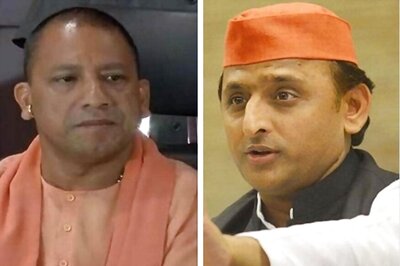
views
Fifty years after the creation of linguistic states, the South is far more integrated with the rest of the country than it was at the time of independence and state formation. We today see a ‘South Indian’ who clearly has multiple identities – each identity is linked to a life experience and real life situation. The success of the South is essentially the by-product of creating language-based states. Above all, the apparent ‘north-south divide’ is not something, which comes out clearly in common citizen’s perceptions. The differences between the two are more on marginal issues and on substantive matters they appear to share the same worldview.
The golden jubilee of the formation of Southern states, provided a window of opportunity to capture what the South represented – as a people, as a distinct region, as a special region of regions and of course as an integral and important part of what makes up India. The CNN-IBN-CSDS-Deccan Herald survey conducted in the Southern States was an effort to feel the social and cultural pulse of the South. The findings of the survey have been analysed by Sandeep Shastri and Yogendra Yadav *. A detailed statement of the methodology adopted to undertake the study is carried along with the article.
On what issues and in what areas did the survey seek to elicit the response of common citizens? What did it mean for an Indian to belong to the South? Was the South in any significant ways different from the rest of the country? How did people in the South view the development of their state and how did it compare with their neighbours in the South? Was the South being fairly treated by the rest of the country? How comfortable was life in the South? How did people in the South view apparently contentious issues linked to the rest of the country? Had the South (and the North) moved towards a meaningful integration? These were just some of the questions that the study sought to tap.
Multiple Identities
People who hail from the South of the Vindhyas are often characterised as ‘South Indians’. The survey found that common people are generally familiar with this term. Do people from the South really see themselves as South Indians? Do those who originally hailed from South India, but today live in other parts of the country, assume ownership for the term ‘South Indian’? Among the South Indian respondents living in the Southern states, more than two out of every three identified themselves as South Indians. If the response of South Indians living in other parts of the country is analyzed, the percentage of those who said that they were ‘South Indian’ rose to more than ninety per cent. The implication is significant. Once people moved out of the region that they belong to their sense of identity with their roots is much stronger and more intense.
Heard about “South India”
There were minor variations in the four southern states on whether people who hailed from this region responded positively to the term South Indian. In Tamil Nadu and Karnataka, over eighty per cent of the South Indian respondents gave a positive reply when asked whether they were South Indians. In Andhra Pradesh, a little over two thirds of the respondents said ‘Yes’ to this question and in Kerala less than one-thirds of those interviewed took this stand.
It is relevant to note that a significant number of respondents in Kerala did not respond positively to the South Indian identity. The survey also reveals that respondents in the state of Kerala were quite assertive in stressing their state identity. It appears that given the migration pattern in Kerala and the percentage of Malyalam speaking population that is spread across the country and abroad, the local (Keralite) and larger Indian identity resonates strongly in the perceptions of people in the state.
Yes
Andhra Pradesh
66
Karnataka
85
* (Sandeep Shastri is the National Convenor, Lokniti Network and Director, International Academy for Creative Teaching, Bangalore and Yogendra Yadav is Co-Director, Lokniti, Centre for the Study of Developing Societies, Delhi).
PAGE_BREAK
A majority of South Indians interviewed in the South unequivocally endorsed their identity as Indians with only a little over fourth of the respondents stressing their regional identity. When it came to the response of South Indians living outside the South, a much higher percentage identified themselves as Indians. This implies that when people from the South move out of their region to other parts of the country two developments can be clearly noticed. Firstly, their identity with the region they hail from becomes stronger and more intense. Secondly, their capacity to relate to the larger Indian identity also becomes clearly apparent. The more distant you are from your own region the stronger are your bonds with both your regional and national identity.
The findings also clearly point out to the fact that the pattern emerging in the South is one of ‘multiple identities’. Increased mobility, greater migration and more opportunities of contact with people across the country and abroad have resulted in individuals wearing different identity ‘hats’ as the situation may demand. When traveling abroad, the identity that becomes prominent is the wider Indian identity. While working within India but outside the South Indian region, the ‘South Indian’ identity assumes significance. When in one’s home state, the sub-regional factor (caste, town, district, village or even family) seems more prominent. It appears as if the formation of linguistic states (the four states of the South are an authentic representation of this experiment) has given a strong voice to a legitimate distinctiveness and also permitted individuals to link themselves to a larger Indian identity.
* (All figures in percentage)
CRITICAL MARKERS
The states of the South have recently celebrated the golden jubilee of their formation. Most respondents in the South were aware of the important milestone that their states had recently passed. It is also interesting to note that the highest degree of awareness about when the state was formed was in Andhra Pradesh. This can be explained in the backdrop of the intensity of the struggle that preceded the formation of that state.
Over the years, many stereotypes have been formed on the differences between the people of the North and South. Are there differences in the intelligence levels of the people in the two regions? When this question was asked to respondents in the South, a majority of them claimed that they (people of the South) were more intelligent than those in the North. Those hailing from the South but living in other parts of the country were much more assertive in making this point.
Non-Southerners living in the South and thus having had the experience of relating to both South Indians and others were equally divided on this question. Non-Southerners living outside South India - who may have had lesser exposure to those from the South, were also equally divided in their opinion on whether those from the North or South were more intelligent.
South Indians
* (All figures in percentage)
Is there a difference in the lifestyle in the North and the South? Are people of either region simpler in their living? The perception of individuals is often linked to the immediate situation that they live in. A majority of the South Indians were convinced that their lifestyle was simpler. On the other hand, among the rest of the Indians, close to a majority believed that the life style of those in the North tended to be simpler.
South Indians
* (All figures in percentage)
PAGE_BREAK
Are there differences in corruption levels in different parts of the country? Can officials be bribed more easily in the North or in the South? Nearly one-thirds of the respondents who took a stand on the issue felt that there was no difference between the two regions. However, a significant number of respondents believed that in the region that they lived it was much easier to bribe officials. In the South, a larger percentage of respondents felt that the South was in that sense more corrupt while in the rest of the country the perception was that officials in North India were more susceptible to being bribed.
South Indians
* (All figures in percentage)
MOVING FORWARD
How do people in the South compare the major indicators of development across the four states? To tap public perception on this issue, respondents were asked to choose which state was the best in terms of select development indicators. While analyzing the data, the respondents who mentioned their home state as being the first have not been included in order to eliminate any bias.
In terms of educational facilities, Kerala was ranked as the first. Respondents seemed to have linked educational facilities with the level of literacy when responding to this question. Karnataka was ranked marginally higher than other states when it came to health facilities. The state scored much higher than its southern neighbours when it came to employment opportunities and growth of the information technology sector with a majority of the respondents voting for Karnataka as the first.
PAGE_BREAK
Within the southern states how do certain social groups feel with regard their safety and security? Among different variables, four were chosen for the survey. Respondents were asked whether there were differences among the four southern states with regard to communal tensions, treatment of dalits, level of conservatism and discrimination against those who lived in a state but did not belong to the South.
While analyzing the data, only the response of the effected social group is taken into account. For assessing communal tensions the response of minorities is analyzed. The response of dalits has been tabulated for the question on dalits. To measure the degree of conservatism the response of women is assessed. On the question of discrimination against those who do not hail from the state, the response of all respondents is included.
Minorities felt that the greatest communal tensions were in Kerala and Karnataka was close behind. Tamil Nadu was seen as the least communally sensitive southern state by the minorities. This attitude reflects recent developments in all these states and the nature of relationship between different religious groups. Nearly half the Dalits saw Andhra Pradesh as the state where their oppression was the most intense. Women saw a high degree of conservatism in Tamil Nadu with the other three states scoring similar per centages on this measure. Andhra Pradesh and Kerala were seen as states where there was limited discrimination against those from other regions. Karnataka and Tamil Nadu were perceived as states with a little more discrimination against those from other regions. Both these states have witnessed a high migration of people from other regions in view of better educational and employment opportunities.
Does the centre discriminate against the South or does this region receive preferential treatment? More than half the South Indian respondents who lived outside the region felt that there was no difference in the treatment meted out to the North and the South by the centre. A more or less similar sentiment was echoed by Non-southerners living in the South and the rest of the country.
The perception was significantly different among the South Indians living in the South. A little over one thirds believed that the south was discriminated against. In the survey, the one state in the south where the respondents categorically asserted that the centre does not discriminate against the region is Tamil Nadu. Here just a little over ten per cent of the respondents felt that the South is discriminated against. Over the years it appears as if the South has come to believe that the centre is more sensitive to the needs and aspirations of the people of the region. It could also be a reflection of the changing power equations at the central level with regional parties (especially from Tamil Nadu) playing a major role in national politics.
* (All figures in percentage)
PAGE_BREAK
TOWARDS MEANINGFUL INTEGRATION
Language has been an important variable in ‘North-South’ relations.
How do people in the South view Hindi? Should Hindi be made compulsory or should people be persuaded to learn the language. It is significant to note that very few respondents felt that they did not want Hindi at all. A majority of the respondents felt that people should be encouraged to learn Hindi and it should not be imposed. The electronic media appears to have played a major role in ensuring the greater acceptability of Hindi in the south. It is also relevant to note that among the South Indians living outside of the southern region, more than two-thirds felt that Hindi should be taught as a compulsory subject. It is also pertinent that a majority of non-Southerners living in South India would like their children to learn a South Indian language. Language has cleared emerged as an important integrating factor.
* (All figures in percentage)
The opposition to English also seems to be whittling down. Very few respondents felt that English should not be taught in schools. A majority felt that the regional language should be the medium of instruction with English being taught as a compulsory subject. Expectedly, those who had the benefit of college education were more supportive of English as the medium of instruction in schools.
* (All figures in percentage)
Films too are an important instrument of integration. More than two thirds of the respondents in South India said that they watched regional language as well as Hindi and English movies. Only one of every five respondents said that they watched only regional language films.
* (All figures in percentage)
PAGE_BREAK
THE BRIDGE OF SOCIAL CONNECTIVITY
There are several indicators of ‘social connectivity’ between the North and the South. The survey sought to tap a few. How comfortable are people with their children marrying somebody from the other region? Would South Indians approve of their sons and daughters marrying Northerners and would North Indians approve of a South Indian son-in-law/daughter-in-law? A little less than one-thirds of the South Indians living in the South were totally opposed to their children marrying North Indians.
Close to half the South Indians living outside South India were opposed to it. The farther you get from your roots the more you wish that your off-spring marries someone from your region! What did non-Southerners have to say? A little over one-thirds of the non-Southerners living in South India were opposed to their children marrying someone from the South. Among non-Southerners in different parts of the country, a majority would not prefer their children marrying someone from the South. Marriage as a social connectivity route is clearly not yet firmly established.
Not at All
South Indian living in South - with non-South Indians
29
South Indian living in the rest of India - with non-South Indians
43
Do people like the food of the other region. Is ‘idli-dosa’ today the monopoly of the South and can the North claim exclusive rights over ‘dal-roti’ and ‘tandoori chicken’? If the survey questions were to be analyzed the answer would be a categorical No. What was the response of South Indians to north Indian food and vice versa? Four out of every ten South Indians living in the South liked North Indian food. More than half of the non-Southerners liked South Indian food. While analyzing this question it is important to look at issues of availability and affordability. Many of the respondents in the South who came from working class and lower middle class backgrounds did not like North Indian food largely because they were not exposed to it and their economic conditions did not allow them to make its consumption a regular feature. The importance of the environment you live in was brought out by the fact that seventy per cent of the South Indians respondents interviewed in Delhi stated that they liked North Indian food.
Yes
South Indian living in South fond of North Indian Food
39
South Indian living rest of India fond of North Indian Food
73
The bridge of ‘social connectivity’ can also be viewed in terms of how much do people of the two regions like those of the other region as a professional colleague or a neighbour. Among the non-Southerners living in the South there was overwhelming support for those from the South as a neighbour, boss or colleague. This could verily be a reflection of the situation that people actually find themselves in and are extremely comfortable with.
Very Much
* (All figures in percentage)
SUMMING UP
The South has been witness to a high degree of assimilation and integration. What was considered to be contentious in the past does not seem to really be reflected in popular perception today – be it the role of language (Hindi vs regional, English vs regional), the attitude of the centre and a host of other indicators. The South as a region and each of the four states as having clear identities are today more integrated than at any moment in the past. This is the success story of linguistic states. ####Methodology of The Golden South Survey


















Comments
0 comment